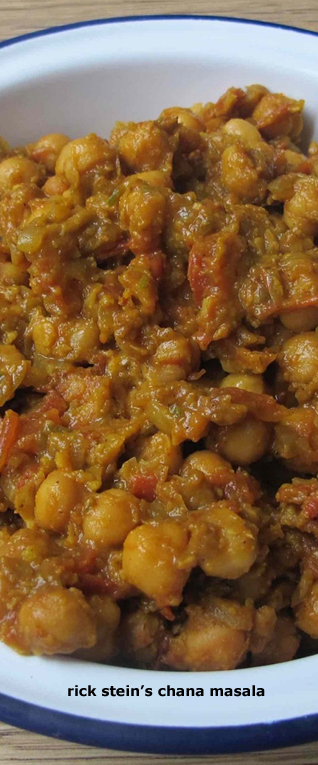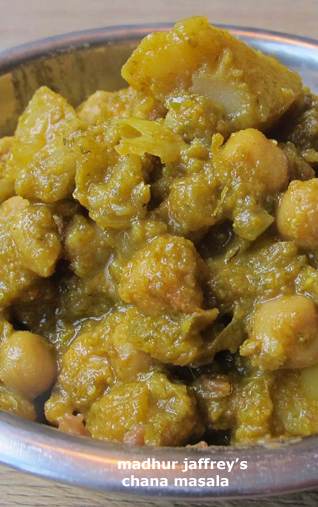Roundtable
How To Make The Perfect Chana Masala
FELICITY CLOAKE
Chana masala, chhole masala, channay, chholay – so many names for such a simple dish, one that Rick Stein claims is probably “the most popular vegetarian curry” from Punjab and the subcontinent, and with good reason.
A dollop of comfortingly bolstering pulses bathed in a thick, tangy, deeply spiced gravy, it’s the kind of food that tastes of home, whether home is Amritsar or Aberdeen.
Though a popular street snack, hawked with enthusiasm on railway platforms and served up in quantity by work and school canteens, as well as being a fixture at “ceremonies and festive occasions” in the Punjab, East or West, according to Cyrus Todiwala, chana masala is also a stalwart of the domestic repertoire.
Mumbai-born chef Maunika Gowardhan notes that “most Indian households will have their own take on it” – a fact that guarantees I’m going to put a few billion noses out of joint this week.
Hey ho: what follows is an easy, fail-safe recipe for a home-style chickpea curry that knocks the chappals off the one from my local takeaway. All complaints should be addressed below the line.
THE PULSES
Anticipating wading through an ocean of rehydrating pulses en route to bed, I’m surprised to discover that only one of the recipes I’ve chosen demands cooking the chickpeas from scratch: Gowardhan simmers hers with a black teabag, which she says is “common practice in Punjabi households”, lending the dish a “rich smoky flavour” and “deep colour”. I can’t taste the tea, but it does give her dish a lovely tan.
Most others give the option of using the tinned sort, with Stein conceding that, as his son produced “a triumph” with “a jar of Spanish garbanzos … maybe I’m too strict on tins and jars” – and indeed, texturally, I can’t tell the difference. The only ones that stand out are the brown chickpeas, or kaala chana, I pick up on a whim at the grocers, which have a drier, slightly harder texture than the larger, creamier kind more commonly found here.
Kaushy Patel of Bradford’s celebrated ‘Prashad’ restaurant simmers the drained, tinned chickpeas in water to soften them, and then uses the cooking water in the curry, as Gowardhan also suggests. This is a clever compromise if you haven’t got time to cook them from scratch, sneaking a little of their earthy, slightly sweet flavour into the gravy.
Gowardhan is also unusual in adding chana daal, or yellow dried split chickpeas, to her dish, which gives it a thicker, heartier texture, though as they take some time to cook, I’ll be leaving them out to make my recipe more versatile. If you starting from scratch, however, then feel free to substitute 50g of the dried chickpeas for chana daal; unlike the chickpeas, they don’t need pre-soaking, and can be cooked in the same pan.
THE BASE
Onions – pureed in Patel’s case – ginger and green chillies are the holy trinity at the root of every chana masala, and everyone except Patel also uses garlic, which is rarely an unwelcome addition as far as I’m concerned.
Tomatoes are another must, and Madhur Jaffrey whizzes them up with garlic, ginger, chillies and fresh coriander to create a tangy, aromatic puree that forms the base of her curry. This, unsurprisingly, gives her recipe a fresher, more herbaceous character than its rivals, which contrasts beautifully with the creamy chickpeas, though if you’re one of those strange people with an aversion to that intriguingly flavoured herb, you can omit it with a clear conscience – everyone else does.
Patel is the only one to use tinned tomatoes, which are generally a safer bet in the UK, although the more acidic profile of the fresh kind works particularly well here, so at the tail end of the season you might still have some luck. Mashing them will yield a thicker, more flavourful gravy; I find the chunks in Cyrus Todiwala’s recipe, in his book ‘Mr Todiwala’s Bombay‘, less satisfying.
Todiwala also adds a few spoonfuls of thick yoghurt to his curry, which I rather like for its richness, but it does dull the sour flavour of the curry slightly, so I’m going to leave it out – though you could serve a dollop on the side.
SPICING
A recipe where the focus, according to Patel, “is really on the balance of spices” that “make all the difference to the flavours of the finished dish”. Those I try demand a dazzling array, from standard cumin and coriander to Gowardhan’s asfoetida, ground pomegranate and black salt (having hunted the last down, I finally discover the source of the sulphurous flavour in so many Indian savoury snacks. Perhaps it grows on you).
Cumin, coriander, turmeric and chilli powder are fairly universal, and I like Patel’s observation that frying the first along with the onion gives the dish a strong savoury “base note”. She builds on that with sweet spices such as cloves, cinnamon and bay, giving her dish an interesting, almost medicinal flavour, while Jaffrey’s cardamom enhances the distinctively zesty profile of her curry. Stein and Patel stir a homemade garam masala into their dishes at the end, which brings the flavours of the spices to the forefront.
Gowardhan and Patel both season their dishes with a little sugar, which I don’t think it needs (though depending on your tomatoes and the sweetness of your tooth, you may disagree) and a sour element is vital. Stein goes for lemon juice, Todiwala a tangy, salty spice blend known as chaat masala, the principal ingredient of which is usually amchoor, or dried green mango powder, and Gowardhan dried and ground pomegranate seeds.
Lemon juice is obviously the easiest to come by for most home cooks in the UK, and does the job perfectly, though if you happen to have any of the others in your kitchen, feel free to experiment.
EXTRAS
Jaffrey adds potatoes to her dish, “a modern version of the chickpeas I ate in the streets of Delhi”, which, like Gowardhan’s chana daal, bulks it out nicely to make a very filling supper – definitely a good option to consider if this is to be a meal in itself.
Which particular meal is up to you of course: according to Patel, “in Lahore it is eaten for breakfast; in Punjab, it is served as a snack and in Gujarat is is treated as a main meal”. Serve with fried or grilled flatbreads or steamed rice – or even as a chana masala toastie or over pasta with parmesan. Hey, don’t shoot the messenger.
* * * * *
FELICITY CLOAKE’S PERFECT CHANA MASALA
Serves 4-6
450g drained cooked chickpeas (or 200g dried, soaked overnight then cooked in fresh water until tender)
1 tbsp vegetable oil
1 tsp cumin seeds
1 large onion, finely chopped
6 garlic cloves
25g root ginger
30g fresh coriander
2-4 green chillies, finely chopped, seeds and all
1 tbsp ground coriander
1-2 tsp chilli powder
1 tsp ground turmeric
400g tin of plum tomatoes, mashed
1.5 tsp fine salt
1 tsp garam masala (to make your own)
1 tbsp lemon juice
Put the drained chickpeas in a pan and add 500ml water. Bring to a simmer and cook for 5 minutes then drain, retaining the cooking water.
Heat the oil in a large, heavy-based pan over a medium heat and when hot, add the cumin seeds. Fry until aromatic, stirring, then add the onion and turn the heat down. Cook until golden brown, stirring regularly. Meanwhile use a pestle and mortar or stick blender to mash the garlic, ginger, 25g fresh coriander and chillies into a paste.
Put this into the pan and cook for a couple of minutes, stirring so it doesn’t catch, then add the ground coriander, chilli power and turmeric (and a splash more oil if necessary) and cook for a couple more minutes.
Stir in the mashed tomatoes, chickpeas and their cooking water and salt. Bring to a lively simmer, then turn down the heat to medium low and cook for 20 minutes or until thickened.
Stir in the garam masala and lemon juice, then allow to cool slightly before serving scattered with the remaining coriander leaves.
* * * * *
THE ROUNDTABLE OPEN FORUM # 154
Chana masala or chhole, whatever you call it, how do you make yours, when do you eat it, and what with? Do you agree with Rick Stein that it’s the most popular vegetarian curry in Punjab and the subcontinent – and if not, what is?
Please post your comments below.
[Courtesy: The Guardian. Edited for sikhchic.com]
September 25, 2015
Conversation about this article
1: Bhai Harbans Lal (Dallas, Texas, USA), September 25, 2015, 11:21 AM.
Chana Masala is my favorite dish and I like the recipe given in this article, except that I do not care for “frying” cumin seeds and onion, etc. I do care very much for my heart which would not like the trans-fat that results from frying any fat. Blocking the good arteries and the heart muscle going into congestive heart failure are not very palatable. Stay away from them, my friends.






